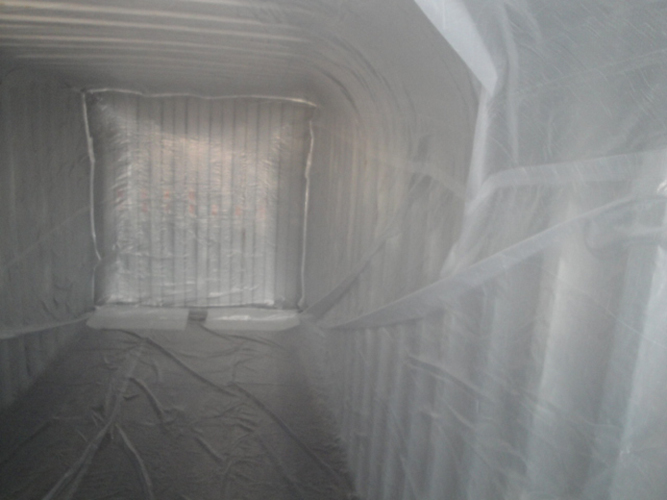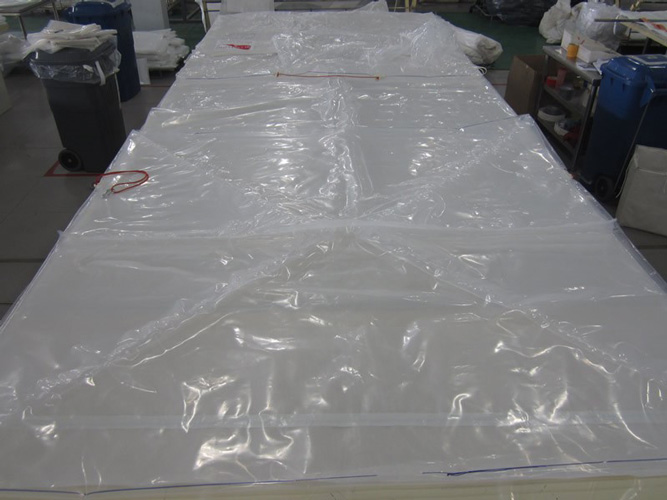When packaging fails, nobody remembers how cheap a price they paid for it. Despite the price, when one pays for a bulk container liner, the expectation is that it performs the job. After all, bulk container liners are created equal since they are a commodity type of bulk bag, right? No, that assumption is completely wrong. In theory, bulk container liners are highly engineered bulk packaging that can safely load and unload up to 25MT of solids in and out of a container. Its reduced price cannot be at the expense of manufacturing quality.
The High Cost of Low Price (and Obsolete) Woven Bulk Container Liners
Woven bulk container liners are the workhorses of the bulk packaging industry to ship containerized bulk solids. They were created more than 20 years ago as a more reliable alternative to the then fragile polyethylene (PE) film bulk container liners.
As they have been widely adopted by shippers, many neophyte opportunistic suppliers have broken into the market and degraded those original quality standards, transforming woven container bulk liners into a shadow of what they once were in terms of safety, performance, contaminant-free environment, and general construction quality.
Woven container liners are still a very labor-intensive product to manufacture in Asia. Therefore, their price commoditization can only be achieved by lowering the costs of raw materials and not gains in productivity due to automation.
The main factor that has made price commoditization possible is its low-strength woven fabric construction, especially in southern Asian countries. In those countries, virgin polypropylene (PP) is often watered-down by co-extruding it with a high percentage of low-cost recycled PP. The final result is a significantly lower strength fabric that will still be required to hold up to 25MT of bulk solids in a container.
If safety means anything to a shipper, then the potential for disaster during discharge from a liner made out of substandard fabric should be dead scary! Operators’ lives are placed on the line while the container is tilted at 30 degrees with still many tons of product held inside.
Woven Container Liner Fabric Minimum Standards
Woven container liners can be made with PP or HDPE. The low-cost container liners are typically made of PP because many of the manufacturers in South Asian countries see this as a side business. They use the same fabric that they already had to make big bags. Therefore, specs may vary from PP to HDPE but these are some of the very least safety requirements with which they should comply:
| Properties | Unit | Test Method | Result |
|---|---|---|---|
| Construction Warp | Inch | Din 53853 | 10 |
| Construction Welf | Inch | Din 53853 | 10 |
| Count Warp | Denier | Din 53864 | 1050 |
| Count Welf | Denier | Din 53864 | 1050 |
| Tensile Strength Warp | N | Din 53857 | 750 |
| Tensile Strength Welf | N | Din 53857 | 750 |
| Elongation Warp | % | Din 53857 | 18-22% |
| Elongation Welf | % | Din 53857 | 18-22% |
Above specifications are typical and can vary +/- 5%
Obsolete Woven Liners
Materials evolve at a very fast pace and plastics, in particular, have grown to a new performance generation to serve the ever more demanding automotive and food packaging industries, among others.
PE films have experienced a renaissance through the use of last generation polymers co-extruded with strength to provide resins such as metallocene, nylon, etc. In reality, it is a completely new generation material of PE film. It’s devoid of any of the weaknesses of those PE films used for bulk container liners almost 20 years ago.
Contamination-prone Woven Liners vs Intrinsically Clean Film Container Liners
Examine some of the most relevant features about the superiority of PE film container liners over any woven container liners in more detail:
Woven container liners for containers are a labor-intensive packaging product to make that requires stitching 6-7 fabric sheets to form them. During this stitching process (around 45-68 meters), loose threads that fall inside of the container liner are generated. The interior of the container liner has to be cleaned or de-contaminated by a crew of operators who manually vacuum the seams of the liner and then blow a current of air through the liner for a final sweep. Even if this operation is done thoroughly, the interior of the liner (a surface that is supposed to be food grade) is being walked all over by the cleaning crew making it food grade incompliant.

Film container liners, on the other hand, are intrinsically clean because their manufacturing procedure does not involve any stitching or an operator entering the liner to perform a duty. The tubular film comes in a roll and is extended flat over a 20’ or 40’ table where, using thermal sealing technology, the back and front panels of the liner are sealed to the body. The liner is at all times flat and unopened in its virgin extruded form.

More contamination problems
The contamination potential for woven container liners is not limited to operators walking inside of the liner or the loose threads. De-lamination of the fabric is probably the worst offender in terms of frequency and extent of the event. Without getting too technical, it would suffice to point out 2 characteristics of the low-cost woven liners that make the de-lamination potential such a threat:
- The woven PP fabric is laminated with a PE film applied in line by extrusion over the web of the PP fabric. PE and PP are not necessarily compatible materials as they have different melting temperatures. Therefore, the bond between the PP fabric and the PE lamination layer is not as strong as it should. Even if the PE layer is co-extruded with PP as a tying layer that enhances the bonding, the potential for a weak formed bond always remains.
- The lamination process is a very delicate one that encompasses the accurate control of many parameters. Most laminating lines in southern Asian countries have very poor quality-control checks and are an outsourced operation, most of the time. This results in an overall deficient fabric lamination job.
Of course, lamination is not even part of a PE film container liner. PE film liners are characteristically laminated, so the entire lamination process required for woven liners is completely unnecessary. Lamination is a truly obsolete feature.
One-sided lamination only
Very simply put, low-cost woven liners have low quality specs. One of the most evident features, besides fabric weakness, is that despite the accepted and original double-sided woven fabric lamination standard, most south Asian manufacturers just laminate one side. Typically, it’s the side of the fabric that faces the container’s interior. In other words, they remove the shield that the external lamination of the fabric provides. This low-cost construction results in a liner that can be easily contaminated by container floor splinters penetrating the fabric and a very high-porosity for humidity penetration.
PE film liners completely lack these lamination issues since they are made of a barrier or shield material.
PE film liners are 6-8 times more humidity-resistant than woven liners
Packaging promises that it will preserve the integrity of the product as it travels the roads and oceans of the world. Even for non-perishables, humidity penetration ranks among one of the top spoiling causes that can rapidly devalue the bulk cargo.
Humidity permeation in materials is measured and benchmarked with Water Vapor Transmission Rate (WVTR) analysis. Here is the statistic data for the WVTR of PE films vs Woven Liners:
- PE film liners: 0.55-1.8 g/m2, 24h – 90% relative humidity
- Woven liners: 3-4g/m2, 24h – 90% relative humidity, assuming there is a double-sided lamination woven fabric
For example, if a 20’ container liner transits the ocean for 30 days, then it can absorb around 1.12 liters of water inside a PE film liner vs 6.12 liters of water inside of a woven liner.
Quantified difference in mechanical properties:
Woven Container Liners vs PE Film Container Liners
A lack of data about this new standard of low-cost woven liners prevents the table from completely portraying the deficiencies of such woven liners. The table below is based on the original quality standard of woven liners.
Woven Container Liners vs PE Film Liners Mechanical Properties
| Woven PP Liners | BULK-FLOW PE Film Liners | |
| Lamination | 20 gsm each side | N/A |
| Lamination Layer/Woven layer adhesion compatibility | LDPE / PP – LOW | N/A |
| Construction | Stitched panels | Tubular |
| WVTR | 3-4 g/m2 24h – 90% RH | 0.55 g/m2 24h – 90% RH |
| Cleaning system | Operator manually vacuums seams | Clean – no seams to vacuum |
| Liner fixation system | Stitched straps or belts | High-strength mechanical clips with hooks |
| Bottotm flap protection | Yes | Yes |
| Side flaps protection | No | Yes |
| Breaking elongation | 15-22% | 800-880% |
| Steel bars required | 5 | 4 |
| Thickness | 125-140 g/m2 | 150 microns |
